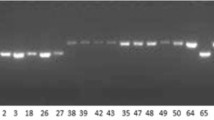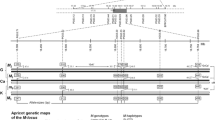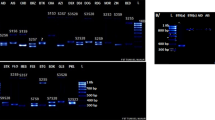Abstract
European pear exhibits RNase-based gametophytic self-incompatibility controlled by the polymorphic S-locus. S-allele diversity of cultivars has been extensively investigated; however, no mutant alleles conferring self-compatibility have been reported. In this study, two European pear cultivars, ‘Abugo’ and ‘Ceremeño’, were classified as self-compatible after fruit/seed setting and pollen tube growth examination. S-genoty** through S-PCR and sequencing identified a new S-RNase allele in the two cultivars, with identical deduced amino acid sequence as S 21 , but differing at the nucleotide level. Test-pollinations and analysis of descendants suggested that the new allele is a self-compatible pistil-mutated variant of S 21 , so it was named S 21 °. S-genotypes assigned to ‘Abugo’ and ‘Ceremeño’ were S 10 S 21 ° and S 21 °S 25 respectively, of which S 25 is a new functional S-allele of European pear. Reciprocal crosses between cultivars bearing S 21 and S 21 ° indicated that both alleles exhibit the same pollen function; however, cultivars bearing S 21 ° had impaired pistil-S function as they failed to reject either S 21 or S 21 ° pollen. RT-PCR analysis showed absence of S 21 °-RNase gene expression in styles of ‘Abugo’ and ‘Ceremeño’, suggesting a possible origin for S 21 ° pistil dysfunction. Two polymorphisms found within the S-RNase genomic region (a retrotransposon insertion within the intron of S 21 ° and indels at the 3′UTR) might explain the different pattern of expression between S 21 and S 21 °. Evaluation of cultivars with unknown S-genotype identified another cultivar ‘Azucar Verde’ bearing S 21 °, and pollen tube growth examination confirmed self-compatibility for this cultivar as well. This is the first report of a mutated S-allele conferring self-compatibility in European pear.





Similar content being viewed by others
Abbreviations
- GSI:
-
Gametophytic self-incompatibility
- S-RNase:
-
Self-incompatibility ribonuclease
- TRIM:
-
Terminal repeat retrotransposon in miniature
- UTR:
-
Untranslated region
References
Binder R, Hwang SP, Ratnasabapathy R, Williams DL (1989) Degradation of apolipoprotein II mRNA occurs via endonucleolytic cleavage at 5′-AAU-3′/5′-UAA-3′ elements in single-stranded loop domains of the 3′-noncoding region. J Biol Chem 264:16910–16918
Bošković R, Tobutt KR, Duval H, Batlle I, Dicenta F, Vargas FJ (1999) A stylar ribonuclease assay to detect self-compatible seedlings, on almond progenies. Theor Appl Genet 99:800–810
Carrera M (2000) Variedades y calidad de las peras en Aragón. Apeph, Zaragoza
Chang S, Puryear J, Cairney J (1993) A simple and efficient method for isolating RNA from pine trees. Plant Mol Biol Rep 11:113–116
Cheng J, Han Z, Xu X, Li T (2006) Isolation and identification of the pollen-expressed polymorphic F-box genes linked to the S-locus in apple (Malus x domestica). Sex Plant Reprod 19:175–183
Crane MB, Lewis D (1942) Genetical studies in pears III. Incompatibility and sterility. J Genet 43:31–44
de Nettancourt D (2001) Incompatibility and incongruity in wild and cultivated plants. Springer, Berlin
Dissanayake DMRKK, Norioka S, Norioka N, Takasaki T, Nakanishi T (2002) Cis-regulatory elements for pistil specific expression in S-RNase promoter region of Japanese pear (Pyrus pyrifolia Nakai). Acta Hortic 587:459–465
Druker R, Bruxner TJ, Lehrbach NJ, Whitelaw E (2004) Complex patterns of transcription at the insertion site of a retrotransposon in the mouse. Nucleic Acids Res 32:5800–5808
Green PJ (1993) Control of mRNA stability in higher plants. Plant Physiol 102:1065–1070
Hormaza JI, Dollo L, Polito VS (1994) Identification of a RAPD marker linked to sex determination in Pistacia vera using bulked segregant analysis. Theor Appl Genet 89:9–13
Kakui H, Tsuzuki T, Koba T, Sassa H (2007) Polymorphism of SFBB −γ and its use for S genoty** in Japanese pear (Pyrus pyrifolia). Plant Cell Rep 26:1619–1625
Kalendar R, Tanskanen J, Chang W, Antonius K, Sela H, Peleg O, Schulman AH (2008) Cassandra retrotransposons carry independently transcribed 5S RNA. Proc Natl Acad Sci USA 105:5833–5838
Lewis D, Crowe LK (1954) Structure of the incompatibility gene. IV. Types of mutation in Prunus avium L. Heredity 8:357–363
Marchese A, Bošković RI, Caruso T, Raimondo A, Cutuli M, Tobutt KR (2007) A new self-compatibility haplotype in the sweet cherry ‘Kronio’, S 5 ’, attributable to a pollen-part mutation in the SFB gene. J Exp Bot 58:4347–4356
Matsumoto S, Komori S, Kitahara K, Imazu S, Soejima J (1999) S-genotypes of 15 apple cultivars and self-compatibility of ‘Megumi’. J Jpn Soc Hortic Sci 68:236–241
McClure BA, Franklin-Tong V (2006) Gametophytic self-incompatibility: understanding the cellular mechanisms involved in ‘self’ pollen tube inhibition. Planta 224:233–245
McGlincy NJ, Smith CWJ (2008) Alternative splicing resulting in nonsense-mediated mRNA decay: what is the meaning of nonsense? Trends Biochem Sci 33:385–393
Modlibowska I (1945) Pollen tube growth and embryo-sac development in apples and pears. J Pomolog 21:57–89
Moriya Y, Yamamoto K, Okada K, Iwanami H, Bessho H, Nakanishi T, Takasaki T (2007) Development of a CAPS marker system for genoty** European pear cultivars harboring 17 S alleles. Plant Cell Rep 26:345–354
Mota M, Tavares L, Oliveira CM (2007) Identification of S-alleles in pear (Pyrus communis L.) cv. ‘Rocha’ and other European cultivars. Sci Hortic 113:13–19
Norioka N, Norioka S, Ohnishi Y, Ishimizu T, Oneyama C, Nakanishi T, Sakiyama F (1996) Molecular cloning and nucleotide sequences of cDNAs encoding S-allele specific stylar RNases in a self-incompatible cultivar and its self-compatible mutant of Japanese pear, Pyrus pyrifolia Nakai. J Biochem 120:335–345
Norioka N, Katayama H, Matsuki T, Ishimizu T, Takasaki T, Nakanishi T, Norioka S (2001) Sequence comparison of the 5′ flanking regions of Japanese pear (Pyrus pyrifolia) S-RNases associated with gametophytic self-incompatibility. Sex Plant Reprod 13:289–291
Okada K, Tonaka N, Moriya Y, Norioka N, Sawamura Y, Matsumoto T, Nakanishi T, Takasaki-Yasuda T (2008) Deletion of a 236 kb region around S 4 -RNase in a stylar-part mutant S sm 4 -haplotype of Japanese pear. Plant Mol Biol 66:389–400
Parsch J, Russell JA, Beerman I, Hartl DL, Stephan W (2000) Deletion of a conserved regulatory element in the Drosophila Adh gene leads to increased alcohol dehydrogenase activity but also delays development. Genetics 156:219–227
Pullmann R, Abdelmohsen K, Lal A, Martindale JL, Ladner RD, Gorospe M (2006) Differential stability of thymidylate synthase 3′ UTR polymorphic variants regulated by AUF1. J Biol Chem 33:23456–23463
Sanzol J (2008a) Characterization of length polymorphisms at the 3′ UTR of the Maloideae S-RNase and its application for S-genoty** in European pear. Acta Hortic (in press)
Sanzol J (2008b) Genomic characterization of self-incompatibility ribonucleases (S-RNases) in European pear cultivars and development of PCR detection for twenty alleles. Tree Genet Genomes (in press)
Sanzol J, Herrero M (2002) Identification of self-incompatibility alleles in pear (Pyrus communis L.) cultivars. Euphytica 128:325–331
Sanzol J, Robbins TP (2008) Combined analysis of S-alleles in European pear by pollinations and PCR-based S-genoty**; correlation between S-phenotypes and S-RNase genotypes. J Am Soc Hortic Sci 133:213–224
Sanzol J, Sutherland BG, Robbins TP (2006) Identification and characterization of genomic DNA sequences of the S-ribonuclease gene associated with self-incompatibility alleles S 1 to S 5 in European pear. Plant Breed 125:513–518
Sassa H, Hirano H, Nishio T, Koba T (1997) Style-specific self-compatible mutation caused by deletion of the S-RNase gene in Japanese pear (Pyrus serotyna). Plant J 12:223–227
Sassa H, Kakui H, Miyamoto M, Suzuki Y, Hanada T, Ushijima K, Kusaba M, Hirano H, Koba T (2007) S-locus F-Box brothers: multiple and pollen-specific F-Box genes with S-haplotype-specific polymorphisms in apple and Japanese pear. Genetics 175:1869–1881
Sato Y, Kurihara A, Abe K, Ogata T, Kajiura I, Kotobuki K, Machida Y (1988) Studies on the mode of inheritance of self-compatibility in Japanese pear. J Jpn Soc Hortic Sci 57:76–77
Sato Y, Abe K, Saito T, Kotobuki K (1992) Selection of S-gene homozygotes and its utilization for S-genotype analysis of ‘Osa-Nijisseiki’. J Jpn Soc Hortic Sci 61:16–17
Sironen A, Thomsen B, Andersson M, Ahola V, Vilkki J (2006) An intronic insertion in KOL2 results in aberrant splicing and causes the immobile short-tail sperm defect in the pig. Proc Natl Acad Sci USA 103:5006–5011
Sonneveld T, Tobutt KR, Vaughan SP, Robbins TP (2005) Loss of pollen-S function in two self-compatible selections of Prunus avium is associated with deletion/mutation of an S-haplotype-specific F-box gene. Plant Cell 17:37–51
Takasaki T, Moriya Y, Okada K, Yamamoto K, Iwanami H, Bessho H, Nakanishi T (2006) cDNA cloning of nine S alleles and establishment of a PCR-RFLP system for genoty** European pear cultivars. Theor Appl Genet 112:1543–1552
Tao R, Habu T, Yamane H, Sugiura A, Iwamoto K (2000) Molecular markers for self-compatibility in Japanese apricot (Prunus mume). HortScience 35:1121–1123
Thompson JD, Gibson TJ, Plewniak F, Jeanmougin F, Higgins DG (1997) The ClustalX windows interface: flexible strategies for multiple sequence alignment aided by quality analysis tools. Nucleic Acids Res 25:4876–4882
Tsukamoto T, Hauck NR, Tao R, Jiang N, Iezzoni AF (2006) Molecular characterization of three non-functional S-haplotypes in sour cherry (Prunus cerasus). Plant Mol Biol 62:371–383
Tsukamoto T, Tao R, Iezzoni AF (2008) PCR markers for mutated S-haplotypes enable discrimination between self-incompatible and self-compatible sour cherry selections. Mol Breed 21:67–80
Ushijima K, Sassa H, Hirano H (1998) Characterization of the flanking regions of the S-RNase genes of Japanese pear (Pyrus serotina) and apple (Malus x domestica). Gene 211:159–167
Ushijima K, Yamane H, Watari A, Kakehi E, Ikeda K, Hauck NR, Iezzoni AF, Tao R (2004) The S haplotype-specific F-box protein gene, SFB, is defective in self-compatible haplotypes of Prunus avium and Prunus mume. Plant J 39:573–586
Varagona MJ, Purugganan M, Wessler SR (1992) Alternative splicing induced by insertion of retrotransposons into the maize waxy gene. Plant Cell 4:811–820
Vilanova S, Badenes ML, Burgos L, Martínez-Calvo J, Llácer G, Romero C (2006) Self-compatibility of two apricot selections is associated with two pollen-part mutations of different nature. Plant Physiol 142:629–641
Watari A, Hanada T, Yamane H, Esumi T, Tao R, Yaegaki H, Yamaguchi M, Beppu K, Kataoka I (2007) A low transcriptional level of S e -RNase in the S e -haplotype confers self-compatibility in Japanese plum. J Am Soc Hortic Sci 132:396–406
Wheelan SJ, Aizawa Y, Han JS, Boeke J (2006) Gene-breaking: a new paradigm for human retrotransposon-mediated gene evolution. Genome Res 15:1073–1078
Witte CP, Le QH, Bureau T, Kumar A (2001) Terminal-repeat retrotransposons in miniature (TRIM) are involved in restructuring plant genomes. Proc Natl Acad Sci USA 98:13778–13783
Wünsch A, Hormaza JI (2004) Genetic and molecular analysis in Cristobalina sweet cherry, a spontaneous self-compatible mutant. Sex Plant Reprod 17:203–210
Yamane H, Ikeda K, Hauck NR, Iezzoni AF, Tao R (2003) Self-incompatibility (S) locus region of the mutated S 6 -haplotypes of sour cherry (Prunus cerasus) contains a functional pollen S-allele and a non-functional pistil S-allele. J Exp Bot 54:2431–2434
Zisovich AH, Stern RA, Shafir S, Goldway M (2004) Identification of S alleles from the European pear (Pyrus communis L.) and the determination of compatibility among cultivars. J Hortic Sci Biotech 79:101–106
Zuccherelli S, Tassinari P, Broothaerts W, Tartarini S, Dondini L, Sansavini S (2002) S-allele characterization in self-incompatible pear (Pyrus communis L.). Sex Plant Reprod 15:153–158
Acknowledgments
This work was possible thanks to Dr. Manuel Carrera who developed the European pear genetic resources at CITA. Financial support for this work was provided by CICYT (Project Grant AGL2006-13529-C02-02) and ‘Grupo de Investigación Consolidado’ A43. The author was supported by a research contract INIA-CCAA.
Author information
Authors and Affiliations
Corresponding author
Additional information
Communicated by R. Schmidt.
Electronic supplementary material
Below is the link to the electronic supplementary material.
Rights and permissions
About this article
Cite this article
Sanzol, J. Pistil-function breakdown in a new S-allele of European pear, S 21 °, confers self-compatibility. Plant Cell Rep 28, 457–467 (2009). https://doi.org/10.1007/s00299-008-0645-3
Received:
Revised:
Accepted:
Published:
Issue Date:
DOI: https://doi.org/10.1007/s00299-008-0645-3




